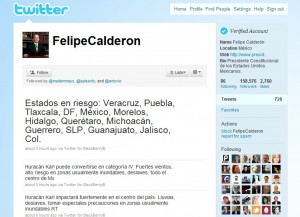 We’re in an extraordinary moment in journalism.
We’re in an extraordinary moment in journalism.
“Who needs newspapers when you have Twitter?” many are saying. Others predict that all media as we know it today will become social and that journalists will become storytellers reporting in “interactive” ways. Granted “interactive” reporting hasn’t caught on yet, but most people today do expect interaction on social networks. That’s the “social” part of social media.
Apparently, the Washington Post, however, doesn’t plan to adapt to the emerging Web 2.0 rules of “engagement” but stay in a “we publish and you listen” one-way (pre-Web 2.0) communications time warp. According to Mashable, Managing Editor Raju Narisetti sent a memo to reporters last week reprimanding them for using the newspaper’s official Twitter account to reply to critics:
“Even as we encourage everyone in the newsroom to embrace social media and relevant tools, it is absolutely vital to remember that the purpose of these Post branded accounts is to use them as a platform to promote news, bring in user generated content and increase audience engagement with Post content. No branded Post accounts should be used to answer critics and speak on behalf of the Post, just as you should follow our normal journalistic guidelines in not using your personal social media accounts to speak on behalf of the Post,” the Oct. 15 memo read.
The memo followed the Post’s publishing of an online guest article arguing that homosexuality is a mental health issue. The article prompted GLAAD, a gay activist group, to rant about it on Twitter and its website. When the official Post Twitter account defended the publishing of the article, saying the paper was working “both sides” of the issue, the GLAAD-led firestorm intensified.
I agree with the Columbia Journalism Review’s (CJR) opinion that the Post reacted wrong and newspapers should engage openly with readers when they disagree with an editorial decision:
“You can’t force Twitter to become the letters page; it’s a completely different tool. Something more interactive and more immediate. It should be used that way.
“The problem was the response itself, not that it was made. It might have been better to say something like this:
“@GLAAD good point. Did it for balance, but upon reflection, realize the error in judgment. Appreciate the watchful eye. And the debate,” the CJR said.
Part of the Post‘s problem could be that Narisetti is gun shy of Twitter after being forced off it last year for urging more spending on health care. Several journalists at other news organizations have lost their jobs for things they posted on Twitter, most notably Octavia Nasr, senior editor at CNN, who agreed to leave the company after she posted a tweet expressing sadness over the death of a Shiite cleric and spiritual leader of Hezbollah.
Newspapers using Twitter to engage critics with legitimate concerns, however, is not the same as reporters and editors using Twitter to comment on controversial or sensitive issues. Engaging critics on Twitter provides an opportunity to correct misunderstandings, apologise for mistakes, build bridges, and ultimately build stronger relationships. Meanwhile, until the majority of people think reporters and editors shouldn’t try to remain objective, opinionated tweets only inflame people on the other side of the issue and tarnish a journalist’s credibility.
The marketing expert Valeria Maltoni wrote about social media in a guest article on Beth’s Blog:
“When I talk with groups about this point [social media and shared ownership] and people ask me what happens if someone says you suck? I respond that I lean forward and ask them to tell me in how many ways I suck. No feedback, no learning—and probably talking to yourself. Only when there’s engagement, there’s sharing and communicating. When you refuse to take this step, you are the barrier.”
It’s funny to imagine the Post a barrier to communication in our increasingly connected Web 2.0 world.
Do you think newspapers should engage critics online? Please share your thoughts below.


